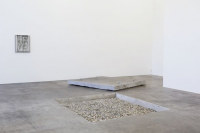
Tjalling de Vries, Unmersion
When I first heard the word unmersion, I didn’t know if it was a neologism or a mass noun that had slipped my vocabulary until now. A fault of the tongue; a close mate of immersion; still with submersion on the brain. There is no entry for unmersion in the dictionary, though, but I read it like an opposite— a projection of something outward from within.
This is a good concept to wield when navigating de Vries’ show, as though the work has been illuminated by some internal function. The way in, perhaps, is the slab that de Vries has removed from the floor, a work titled Grave Mistake. I would not describe this alteration as an excavation, or a digging. Instead, the work feels like a reversion, as though the bed of stones had been dormant beneath Jonathan Smart’s floor all along.
This work seems to ground Unmersion as a show that speaks to a sculptural lineage that is really grounded in Canterbury. There is a tension between the absent section of the floor and the proximity of the concrete volume that previously stopped this gap. The pull of a puzzle piece is that we want to push it back in, make something whole again. As such, de Vries’ work is absolutely concerned with the formal— with visual weight, line, light, and positive and negative space and with the energy that all of these things impart.
The mechanics of this work also translate to the paintings included in Unmersion. De Vries’ has painted on reemay, a type of spun bound polyester. I learn that this material is particularly resilient against humidity, time and temperature. It is absorbent too, so it takes on the paint as its own. On one, a dark green is worn and smudged to reveal a texture like wood grain, and on another, rust tracks score the image. Like the stones, the faded quality of this layer of paint makes the painting feel like a restoration. The lines in the foreground are both mechanical and gestural, like something computer-generated, a cursor dragged across the screen. By combining reemay with aesthetics of the mechanical, a play with preservation and materiality occurs.
The third kind of work that I think of in Unmersion is Reicharm, a row of five light bulbs tall on stands, and blinkering on and off at intervals. The mechanisms inside, making a clicking as the lights turn on and off, so this work is sonic too. As with the paintings, de Vries is working in a mode of industrial poetics. I see the lamps as a lighting that is about movement forward, so I think of a train crossing over railway tracks, sparse boats docking at the harbour, a line of right hand indicators doggedly waiting on the ave.
IMAGE
Tjalling de Vries, Unmersion, installation view, front gallery. Photograph: Vicki Piper.
